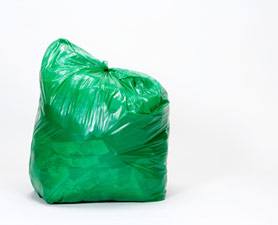
THE GIST
Buying biodegradable products can ease your conscience, but they don’t necessarily do much for the Earth. Biodegradable products can do more harm than good for the environment if they end up in landfills. One of the best ways to reduce your impact on the Earth is to use less and throw less away.
Buying “biodegradable” products is an easy way to reduce guilt about your impact on the Earth.
But when biodegradable trash ends up in landfills, it breaks down more quickly than ordinary garbage does, suggests a new study. The result is a more rapid release of methane, a greenhouse gas that contributes to global warming.
Some landfills collect methane gas and convert it to energy, but many don’t. And in those cases, biodegradables may actually be worse for the environment than ordinary trash — at least at the end of a product’s life — according to the study.
The findings don’t necessarily mean that all biodegradables are bad. In many cases, they are in fact greener, especially if they are disposed of correctly. The point of the study was to simply point out that biodegradables aren’t always everything they’re cracked up to be.
NEWS: ‘Biodegradable’ Doesn’t Always Mean Earth-Friendly
“I want to caution that I have focused solely on the disposal, end-of-life phase,” said lead researcher Morton Barlaz, an environmental engineer at North Carolina State University in Raleigh.
“If you are truly asking which is better or worse, you should look at the emissions from the manufacturing phase plus disposal for whatever materials you’re trying to compare,” he said. “Nonetheless, what I tried to do is attack this notion that biodegradability is always desirable.”
To assess the environmental impact of biodegradable products after they are thrown away, Barlaz and colleague James Levis focused on landfills in the United States, which take in 135 metric tons of municipal solid waste each year, according to estimates by the Environmental Protection Agency.
Even though hundreds of U.S. landfills convert gas into energy, hundreds don’t, the researchers found. Overall, landfills are the second largest contributor of human-produced methane gas.
For the study, the scientists used a computer model to get an average estimate for how much methane emerges from different types of trash across all types of landfills. Products that break down the most quickly, they reported in in the journal Environmental Science & Technology, also generate the most methane.
“We showed that if a material biodegrades quite slowly, on the order of newsprint, we get a favorable result,” Barlaz said. “But if it degrades rapidly, it’s doing more harm than good.”
The finding should not be over-sensationalized or taken out of context, warned Ramani Narayan, a chemical engineer at Michigan State University in East Lansing and science consultant to the Biodegradable Products Institute.
The study puts undue attention on PLAs and PHAs, two types of biodegradable plastic, Narayan said, even though those materials make up just 1 percent of total biowastes that get into the municipal solid waste stream. A far more positive environmental impact would come from diverting food and yard wastes to composting facilities, instead.
Narayan pointed to a headline in Resource Recycling, a trade magazine, which claimed: “A new study out of North Carolina State University casts doubt on the environmental benefits of biodegradable materials, suggesting that as they break down they release a powerful greenhouse gas.”
NEWS: Biodegradable Styrofoam Made of Milk, Clay
“That is a totally misleading statement,” Narayan wrote in an email. “More than 50 percent of traditional biowastes that end up in landfills do the same thing! And bio-based products like PLA were designed for end of life options like composting to promote food and other biowaste diversions from landfill and not to go into landfills.”
Getting biodegradable products into composting facilities is the key to making them worth using, Barlaz said. To minimize your own environmental impact, he suggested first of all to reduce how much you consume and throw away in the first place.
Biodegradable lawn bags are still a good choice because they automatically get turned into compost. But if you’re considering buying biodegradable plastic dishes and utensils for your next picnic, it might also be worth looking first into how your community deals with ordinary trash.
Is there a large-scale composting facility near you? If not, does your landfill collect methane gas to either burn or convert to energy?
“We had friends over for dinner who were excited because a person who organized community dinners said they were switching to biodegradable plates,” Barlaz said. “If I were in that group, I would object. I think they do more harm than good.”
Article courtesy of news.discovery.com

